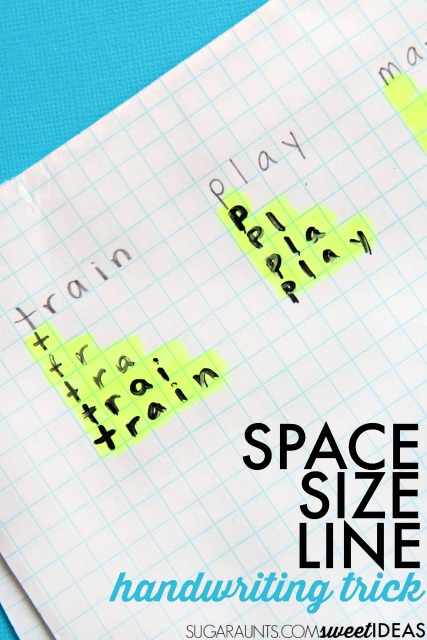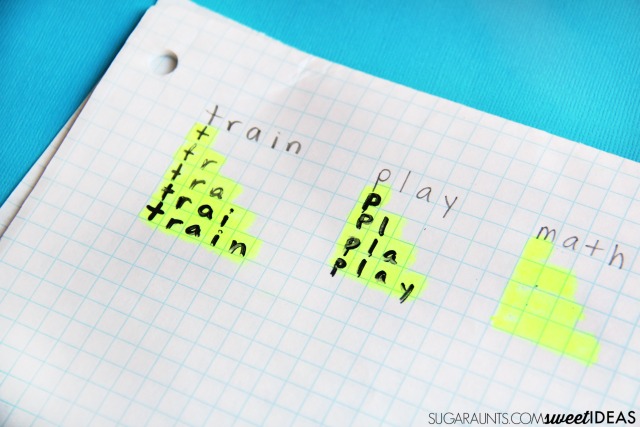Today, I have a great occupational therapy trick and it uses writing on graph paper as a tool to support the spatial awareness needs. This graph paper handwriting tool is an easy way to teach kids how to place letters with appropriate letter spacing, letter size, and line awareness when writing. We’ve shared how to use graph paper for therapy including many OT goal areas in the past, but this letter spacing activity is a hit for working on letter formation and spacing. Try using this trick when visual motor integration is a concern or when students have difficulty with legibility in handwriting.

Writing on Graph Paper for Legibility
This activity is just one of the many spatial awareness and letter size resources we have here on the website. There’s a reason why we cover so many specific tools when it comes to handwriting legibility: spacing between letters is a visual perception task that impacts overall neatness and readability of written work.
When students who struggle with the underlying components of handwriting use regular writing paper or notebook paper, you can end up with written material with a variety of issues:
- Inconsistent letter size
- Mixed letter case
- Inconsistent and sloppy line use
- Words and letters that run together
Taking that a bit further, common handwriting concerns involve overshooting lines, poor placement of letters, and varying size of letter creation. Using graph paper is just part of a simple trick to help with each of these areas.
All of this impacts written work.
That’s where writing on graph paper comes into play. As occupational therapy professionals, we use graph paper as an adaptive paper format for promoting spatial use, line use, consistent letter size, and even slowing down the written work.
Writing on graph paper is a great alternative to typical lined paper designs. In the classroom, you see many different styles of lined paper: double rule, single rule, college rule, and then letter formation worksheets with varying line size and visual prompts. When we use grid paper in handwriting, we have a consistent box for each letter and even spacing between the letters.
This post contains affiliate links.
If you missed yesterday’s blog post, you’ll want to read over another idea that encourages development and strengthening of several skills: using transfer paper to help with letter formation, letter size, line awareness, and pencil pressure.

Writing on graph paper to help with handwriting:
Use graph paper that is appropriately sized to your child’s handwriting size needs.
There are various sizes available: (affiliate links included)
- 1/4 inch squares
- 1/2 inch squares
- 1 inch squares
- And even Dot grid squares (for visual prompts without the lines)
Each category of paper can be used with different ages or stages of writing development. And, those different types of paper variations can be used for different students. Use the larger grid paper for kindergarten or 1st grade.
Use the middle grid paper with 2nd grade or 3rd grade.
Use the smaller gid paper with older grades and even through middle school and high school.
There are even graph paper PDFs out there. Check out our post on free adapted paper for some ways to print different options. These various templates are nice because you can try different options to find out what type of paper works best for the needs you are targeting.
The nice thing about handwriting on graph paper is that a pack of graph paper is often used in math and can readily be found in classroom, plus it’s not a type of paper that will stand out among peers, so this makes it more likely to be used and carryover of handwriting skills to be achieved.
Tips for Improving writing with graph paper
Let’s take this handwriting tool a bit further and cover interventions that use graph paper as a writing strategy. The ideas listed below are some ways to improve writing skills, and you can pick and choose the activity ideas that work for the specific individual, based on needs.
1. Using the appropriately sized grids, use a highlighter to create pyramid style boxes for practicing word copying. For each word, create a pyramid of highlighted boxes that stack the letters so the child practices the word with increasing motor plan effort.
For example, when practicing the word “play”, the child would practice “p”, then “pl”, then “pla”, and finally “play”.
Practicing a word in this manner allows the child to shift their vision down to the next line with a visual cue to correct any mistakes that they made in letter formation. It is important to monitor kids’ work as they begin this activity to make sure they are forming letters correctly and not building on inaccuracies in letter formation or organizational components (size and space of letters).
2. Work on letter size. Use the grid lines as layouts to define a specific writing space for letters. You can target formation of tall letters by using two grids, or target tail letters by drawing a pen line around two grids (one above the baseline and one below the baseline.
Some students might need a more concrete version of the grid spaces. Cut out two boxes or one box and use that along a baseline on a blank piece of printer paper to practice writing different sizes of letters.
You can also target letter size by using a highlighter marker to identify the writing space on graph paper.
of the paper to The grid of the graph paper is a huge tool in allowing the child to form letters with constrictions on letter size, spacing, and line awareness.
3. Finally, when the child writes a whole word, place a piece of paper under the last highlighted grid. The paper should have normal lines without graph paper type of grids. By placing the paper under the grids, the child can copy the style of writing that they used when writing the whole word. Transferring the spacing, size, and line use to regular paper uses the visual cue of the graph paper with improved accuracy.
It is important to monitor kids’ use of the graph paper and writing each letter of the word in repetition. Sometimes, kids will attempt to complete an activity like this one quite quickly in order to “get it over with”. In those cases, letter size, letter spacing, and line awareness can suffer. Try to limit the number of words that are practiced with this method.
More ways to explore writing on graph paper
Other ways to use graph paper to practice handwriting accuracy:
- Use the pyramid style of writing to practice spelling words and sight words.
- Try using graph paper to write written responses to writing prompts.
- Use graph paper for writing responses on worksheets.
- Use graph paper to help kids who need extra work on margin awareness.
- Pencil Pressure Simple Handwriting Trick
- Sandpaper Letter Formation Trick
- Boxes and Dots Handwriting Method
- Easy Trick for Tripod Pencil Grasp

The Handwriting Book covers everything you need to know about handwriting, guided by development and focused on function. This digital resource is is the ultimate resource for tips, strategies, suggestions, and information to support handwriting development in kids.
The Handwriting Book breaks down the functional skill of handwriting into developmental areas. These include developmental progression of pre-writing strokes, fine motor skills, gross motor development, sensory considerations, and visual perceptual skills. Each section includes strategies and tips to improve these underlying areas.
- Strategies to address letter and number formation and reversals
- Ideas for combining handwriting and play
- Activities to practice handwriting skills at home
- Tips and strategies for the reluctant writer
- Tips to improve pencil grip
- Tips for sizing, spacing, and alignment with overall improved legibility
Click here to grab your copy of The Handwriting Book today.

Colleen Beck, OTR/L has been an occupational therapist since 2000, working in school-based, hand therapy, outpatient peds, EI, and SNF. Colleen created The OT Toolbox to inspire therapists, teachers, and parents with easy and fun tools to help children thrive. Read her story about going from an OT making $3/hour (after paying for kids’ childcare) to a full-time OT resource creator for millions of readers. Want to collaborate? Send an email to contact@theottoolbox.com.






